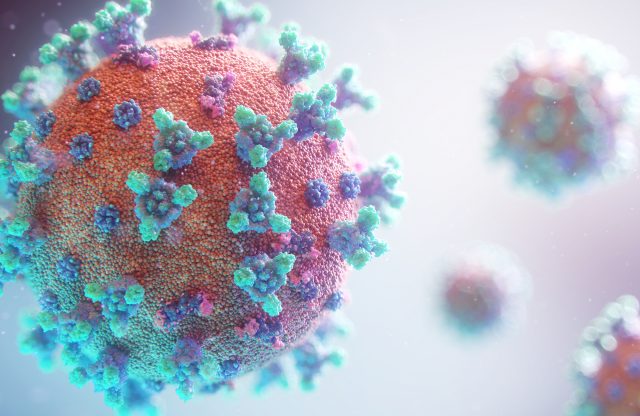Dr Robert Hess: The flu season is just around the corner

Dr Robert Hess – 10/28/2021
Dr Robert Hess: The flu season is just around the corner: What you need to know about the influenza season in general and high-dose vaccines in particular.
Social distancing, face coverings and strict hygiene controls not only reduced the spread of SARS-CoV-2 last year but also of influenza viruses. Flu activity is currently still at a low level, but nonetheless slightly higher than at this time in previous years. Researchers and authorities in the USA and Europe are predicting that a particularly virulent wave of influenza will hit the northern hemisphere in the winter months of 2021/22 and are therefore advising senior citizens to get a shot of the relatively new high-dose vaccines. What exactly are high-dose vaccines? And what can we expect from this year’s crop of flu vaccines?
Are we really in for a tough flu winter?
When a vaccinated or recovered individual is next exposed to the relevant pathogen, his or her immune system learns to attack in a speedier and more targeted manner. Last year, the flu season failed to materialize, and our immune systems missed out on the annual refresher course in combating the flu. Consequently, the influenza viruses may find it easier to spread this winter. Moreover, in the absence of the customary training, individuals are also less able to defend themselves against the flu because their own immune response is no longer as broad and effective. This is certainly the case for the unvaccinated.
Which flu vaccines will be deployed in the 2021/22 season?
Multiple influenza vaccines from different manufacturers are available in the USA and Europe. All vaccines contain the antigens specified by the WHO. Most licensed influenza vaccines for children and adults are of the inactivated kind, containing “killed” viruses or virus components, the only exception being Fluenz Tetra which is an inhaled live vaccine. The so-called tetravalent (alternatively quadrivalent) influenza vaccines protect against four different virus subtypes, namely H3N2, H1N1 (both of influenza A origin) and the two influenza B pathogens.
In Germany, a high-dose vaccine is now recommended for the first time this season for people aged 60 and above. In the United States, the high-dose flu vaccine has already been available since 2019. Containing four times the number of antigens, it could make a big difference in the coming winter season. Generally, any influenza vaccine takes up to 14 days to build up full protection.
What is the high-dose vaccine?
In Germany, the high-dose influenza vaccine goes by the name of Efluelda and is manufactured by Sanofi-Pasteur. Like the other influenza vaccines being made available this season, Efluelda is of the tetravalent variety and contains the vaccine antigens of the influenza strains as recommended by the World Health Organization. However, the dose of aCommittee on Vaccination (STIKO).ntigens is four times higher than in conventional influenza vaccines (i.e. 60 µg instead of 15 µg of hemagglutinin) for each of the four influenza strains. The EU Commission approved Efluelda for people aged 65 and over in May 2020, which was then extended to everyone aged 60 and over in February 2021. It is therefore fully compliant with the directions of the German Standing Committee on Vaccination (STIKO).
In the USA, Sanofi already markets the high-dose flu vaccine under the name Fluzone High-Dose Quadrivalent Influenza Vaccine. It was approved by the FDA (Food and Drug Administration) in July 2019. Sanofi Pasteur also previously had a high-dose flu vaccine in the USA, but it only protected against three strains of influenza. The trade name was Fluzone High Dose.
Why is a high-dose vaccine recommended for the elderly (60 or 65 years plus)?
Globally, nine out of ten people who are hospitalized or even die from influenza infection are older than 65 years. In the United States, between 70% and 85% of deaths and between 50% and 70% of hospital admissions related to seasonal flu occur in people aged 65 and above. This is partly because the human immune system declines with age. The weakening of the immune system can result in older people no longer responding well to the flu vaccine. The effectiveness of conventional influenza vaccines is as much as one-third lower in this group.
A study published in the New England Journal of Medicine showed that the administration of a high-dose vaccine in this group reduced the number of laboratory-confirmed influenza cases by 24% compared to a standard vaccine. In addition, the risk of hospitalization was reduced by almost 7%. A stronger immune response (i.e. higher antibody levels) was demonstrated, thereby vindicating the use of the vaccine to stimulate an aging immune system.
What about possible side-effects?
Due to its increased strength, a high-dose vaccine has a higher reactogenicity, so that local side-effects at the injection site (pain, redness, swelling) may occur more frequently. The symptoms usually disappear after a few days. As part of an Australian study, scientists conducted a survey on side-effects among almost 20,000 individuals who had received the high-dose vaccine. Around nine percent said they had some sort of reaction to the vaccine. The most common complaints were local pain, swelling with redness, and a high temperature.
Overall, the side-effect rate for the high-dose vaccine was about 30 percent greater than that for the conventional flu vaccine. Yet only 56 out of 20,000 high-dose vaccine recipients felt it was necessary to seek medical attention because of this. It is entirely to be expected that the immune system is stimulated more strongly by an increase in dose. This can be observed with almost all vaccinations. Researchers in European countries such as Germany can also draw on data from the USA, which has already been using the high-dose influenza vaccine for several years without any major problems.
To what extent are the high-dose vaccines compatible with other vaccines?
When injected in combination with other vaccines, the unpleasant side-effects are somewhat more noticeable. According to one study, this is especially true for the pneumococcal vaccine, which is often administered together with the influenza vaccine. The combination tripled the rate of those reporting temporary local pain or high temperature to 18%. When the influenza vaccine was combined with a herpes zoster virus vaccine against shingles, there were no increased side-effects. Regarding concurrent vaccination with a coronavirus vaccine (which is an approved method), we can expect reactions to be more common than when administered separately. However, unpublished data from the UK showed only slightly increased vaccine reactions. The immune response to both pathogens was also not reduced.
What level of protection do flu vaccines offer this year?
There are influenza A and influenza B viruses in circulation. The former are considered particularly dangerous. Influenza A viruses are divided into H3N2 and H1N1 viruses (H stands for the enzyme hemagglutinin and N for neuraminidase, the numerical element denoting different subgroups of the enzymes). Hemagglutinin and neuraminidase are the spikes that protrude from the surface of the virus and the most important recognition features for the defense cells. An immune system trained for H3N2 is therefore less able to defend itself against H1N1 pathogens.
Unfortunately, H3N2 and H1N1 pathogens regularly change details on their spikes, which is one of the reasons why a flu infection or vaccination does not necessarily provide immunity against the pathogens that come around the following season. For vaccine developers, the mutability of the flu virus means that they constantly have to adapt their vaccines.
Because production starts months in advance, the WHO closely monitors flu viruses circulating in more than 150 different geographical locations. Based on the data gathered, the organization identifies the pathogens for which the vaccines have to be formulated. The success of this forecast is variable and is the main reason why the effectiveness of vaccines fluctuates between 10 and 60 percent from season to season. An efficacy of 60% was last achieved in the 2010/11 season; in recent years, the efficacy has been between 30 and 45%.
The same applies to the influenza B viruses, except that they are less prone to change. They are divided into two types, the so-called Yamagata lineage and the Victoria lineage. However, the Yamagata lineage has disappeared from the scene since the pandemic and is possibly extinct.
The accuracy of the forecast for this winter can be gauged from Australian data. The current vaccine seems to protect very well against H1N1 and the B viruses, but for H3N2, the prognosis was less encouraging: according to the Australian Government Department of Health, all 20 H3N2 samples showed significant antigenic differences from the vaccine, indicating that protection against H3N2 could be in the low percentage range.
If you have any further questions on this topic or are unsure which flu vaccine you should choose (or indeed whether you should get vaccinated at all against influenza), please do not hesitate to get in touch with us. In the case of individual clients for whom we strongly recommend a high-dose vaccine, we will be contacting them privately.

